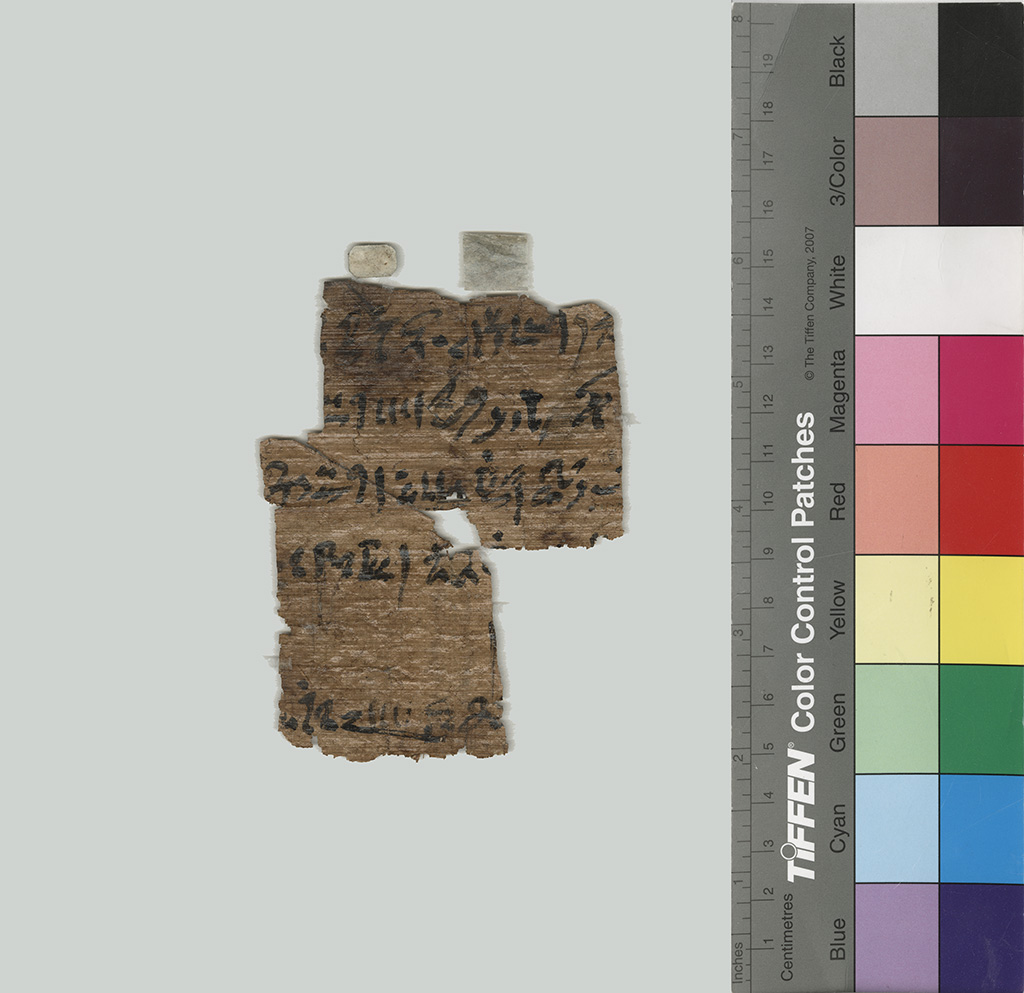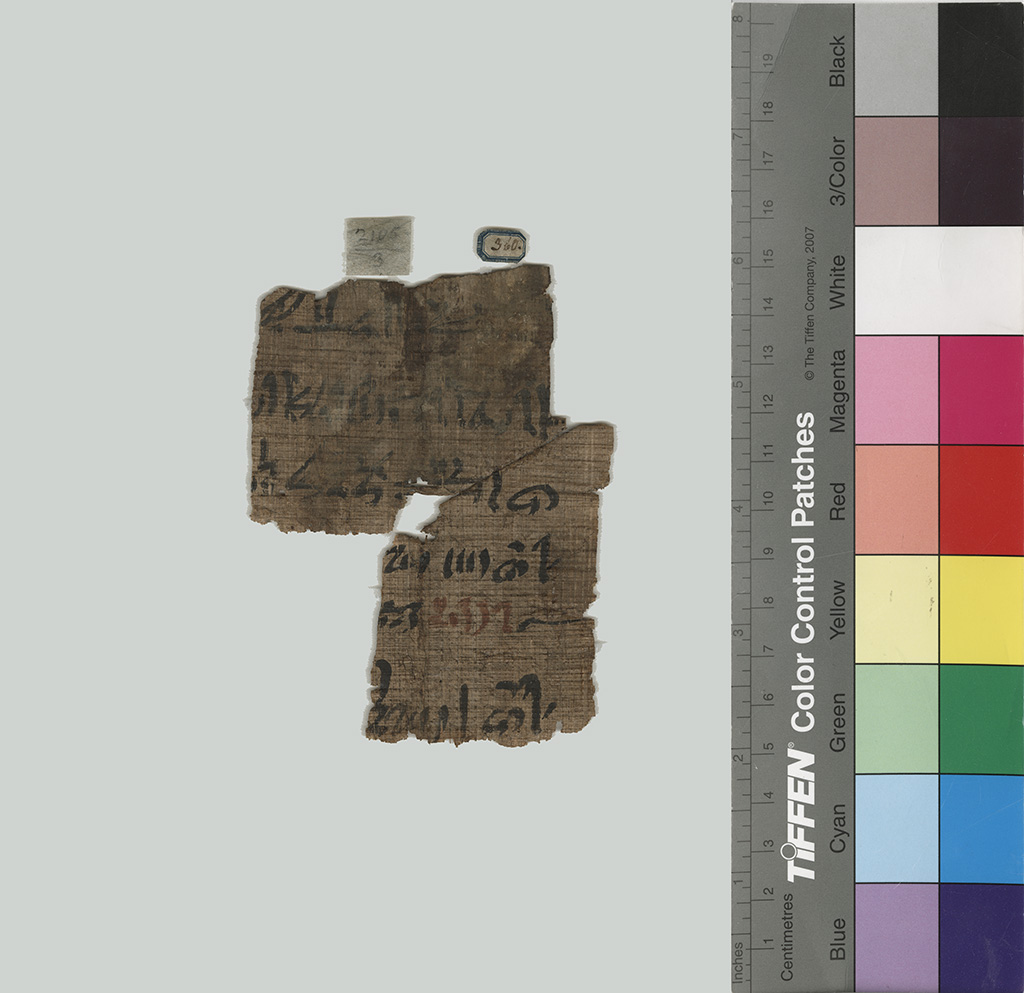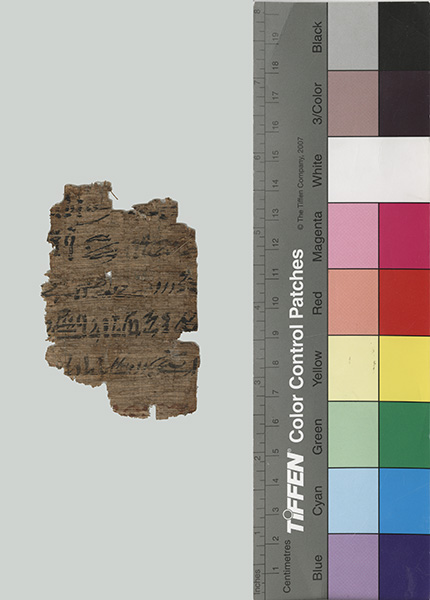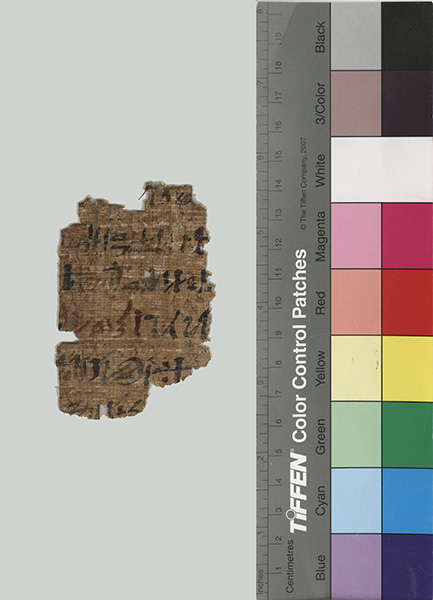Abstract
This small article is a foretaste of the richness in historical data provided by the thousands of papyrus fragments contained in the archives from the ancient workmen’s community of Deir el-Medina now gradually consultable in the online database TPOP.
Thanks to the unfailing diligence of the curator of the papyrus collection in the Museo Egizio, Susanne Töpfer, and her team of collaborators, the almost Herculean work of creating an online database of the dozens of hieratic papyri and the thousands of fragments has made considerable progress.1 The subsequent work of transcription and searching for joins and/or fragments belonging to the same original document is meanwhile in full swing.
Publications of several documents have already seen the light, and more are in various stages of preparation. Many fragments will hopefully end up in publications of complete documents, but on account of their text passages with historically relevant information the versos of two fragments deserve preliminary advance publication.
CP29/035 = Cat.2105/360 verso
https://papyri.museoegizio.it/o/473257
The recto of this fragment (Fig. 1) bears six incomplete lines of a list of commodities, most likely dating to the mid-20th Dynasty. The passage I am concerned with here is on the verso (Fig. 2).
CP29/035 = Cat. 2105/360, recto. Scan by Museo Egizio.
CP29/035 = Cat. 2105/360, verso. Scan by Museo Egizio.
Transcription

Transliteration
(x+1)
(x+2)
(x+3)
(x+4)
(x+5)
(x+6)
Translation
(x+1) of the two scribes of the river-[bank …]
(x+2) retainer Userhatmose, retainer […]
(x+3) This day: giving the remainder […]
(x+4) Regnal Year 4 Month III […]
(x+5) Entered (for) the left side from […]
(x+6) Regnal Year 1 Month IV of
Commentary
-
(1) The two scribes are most likely members of the team of four
rwDw -agents of the riverbank mentioned in O. Ashmolean Museum HO 53, rt. 3 (Černý-Gardiner, Hieratic Ostraca, 1957, pl. XLIX, 1). - (2) A retainer Userhatmose is not known from other sources.
The importance of the text on this fragment lies in lines 4 and 6. The few incomplete lines doubtlessly present fragmentary journal notes,2 in view of the paleography dating to the second half of the 20th Dynasty. The dates in lines 4 and 6 indicate a change in a monarch’s reign between a Regnal Year 4 Month III of
CP37/092 verso
https://papyri.museoegizio.it/o/474257
The recto of this fragment (Fig. 3) bears six incomplete lines of a journal text dating to the second half of the 20th Dynasty. Again, the text we are concerned with here is on the verso (Fig. 4).
CP37/092, recto. Scan by Museo Egizio.
CP37/092, verso. Scan by Museo Egizio.
Transcription

Transliteration
(x+1)
(x+2)
(x+3)
(x+4)
(x+5) […]
(x+6) […]
Translation
(x+1) [Reg]nal Year 15, [Month I of
(x+2) food basket […]
(x+3) crossing to the West by […]
(x+4) Regnal Year 15, Month I of
(x+5) […] King Horemheb […]
(x+6) […] distributing grain rations […]
Commentary
This fragment bears six incomplete lines of a journal text from Regnal Year 15 of Ramesses IX. The incomplete state of the fragment slightly hampers a definite reconstruction of the event recorded in lines 4 and 5, but parallel records in other journal texts may help to offer a solution. Notably, during the 20th Dynasty the anniversaries of both the accession to the throne and the date of death of several deified or venerated monarchs were observed in the community of Deir el-Medina.10 Among these first and foremost are the founder patrons of the village, Amenhotep I and his mother Ahmose-Nefertari, followed by Sethi I, Ramesses II and Ramesses III.11 In the journal texts these events are usually noted in similar terms:
The accession of Ramesses II:
P. Turin Cat.1898 + Cat.1937 + Cat.2094/244, rt. 5,15: III
P. Turin CP21/004 (unpub.), rt. 3: III
The accession of Ramesses III:
O. DeM 55, vs. 1-2: I
P. Turin Cat.1898 + Cat.1937 + Cat.2094/244, rt. 2,26: I
The death of Sethi I:
O. Ashmolean Museum HO 11, vs. 7: III
O. Cairo 25503, vs. 4: [III
The death of Ramesses II:
P. Turin Provv.8538, rt. I, 5: II
One event recorded in a journal text but not yet noticed in this respect is: P. Turin Cat. 1898 + Cat. 1937 + Cat. 2094/244, rt. 5,10: III
Bibliography
Antoine, J.-C., “Ramsès XI, le premier prophète d’Amon et l’ascension de Piankh à Thèbes pendant l’Aire de la Renaissance”, JEH 12 (2019), pp. 1–35.
Barwik, M., The Twilight of Ramesside Egypt: Studies on the History of Egypt at the End of the Ramesside Period, Warszawa 2011.
Beckerath, J. von, Chronologie des pharaonischen Ägypten: die Zeitbestimmung der ägyptischen Geschichte von der Vorzeit bis 332 v. Chr. (Münchner Ägyptologische Studien 46), Mainz 1997.
Botti, G. & T.E. Peet, Il Giornale della Necropoli di Tebe (I papiri ieratici del Museo di Torino), 2 vols., Torino 1928.
Cannuyer, C., “Encore la date de l’accession au thrône de Ramsès XI”, GM 132 (1993), pp. 19–20.
Černý, J., Ostraca hiératiques: nos 25501-25832 (CGC 87), 2 vols., Le Caire 1930-1935.
Černý, J., Catalogue des ostraca hiératiques non littéraires de Deir el Médineh. [Tome I] (nos 1 à 113) (DFIFAO 3), Le Caire 1935.
Černý, J. and A.H. Gardiner, Hieratic Ostraca, Oxford 1957.
Davies, B.G., Life Within the Five Walls. A Handbook to Deir el-Medina, Wallasey 2018.
Demarée, R.J., “Announcement of the Passing of Ramesses II”, JEOL 46 (2016-2017), pp. 117–21.
Gardiner, A.H., “Adoption Extraordinary”, JEA 26 (1941), pp. 23–29.
Gardiner, A.H., Ramesside Administrative Documents, Oxford 1948.
Jauhiainen, H., “Do Not Celebrate Your Feast Without Your Neighbours”: A Study of References to Feasts and Festivals in Non-Literary Documents from Ramesside Period Deir el-Medina, Helsinki 2009.
McDowell, A., “Awareness of the Past in Deir el-Medîna”, in: R.J. Demarée and A. Egberts (eds.), Village Voices: Proceedings of the Symposium ‘Texts from Deir el-Medîna and Their Interpretation’, Leiden May 31 – June 1, 1991, Leiden 1992, pp. 95–109.
Moezel, K. van der, Administrative Hieratic from Dynasties 19 and 20. Case Studies on Selected Groups of Ostraca with Necropolis Administration (Hieratic Studies Online 4), Mainz 2022, http://doi.org/10.25358/openscience-7839.
Ohlhafer, K., “Zum Thronbesteigungsdatum Ramses’ XI. und zur Abfolge der Grabräuberpapyri aus Jahr 1 und 2
Töpfer, S., “The Turin Papyrus Online Platform (TPOP): An Introduction”, RiME 2 (2018).
Notes
- For this project, see Töpfer, <i>RiME</i> 2 (2018).↑
- For journal notes, see the lemma “Journal of the Necropolis” in: Davies, <i>Life Within the Five Walls</i>, 2018, pp. 162-164, and Van der Moezel, <i>Administrative Hieratic from Dynasties 19 and 20</i>, 2022, pp. 25-27.↑
- Botti-Peet, <i>Il Giornale della Necropoli di Tebe</i>, 1928, pl. 55 and pl. 55 text d.↑
- Cannuyer, <i>GM</i> 132, 1993, pp. 19-20; Ohlhafer, <i>GM</i> 135, 1993, pp. 59ff.↑
- E.g., Beckerath, <i>Chronologie des pharaonischen Ägypten</i>, 1997, p. 107; Barwik, <i>The Twilight of Ramesside Egypt</i>, 2011, p. 39; Antoine, “Le premier prophète d’Amon et l’ascension de Piankh à Thèbes pendant l’Aire de la Renaissance”, <i>JEH</i> 12, 2019, p. 3.↑
- P. Turin Cat. 1888 + Cat. 2095, rt. 2,14; <i>Gardiner, Ramesside Administrative Documents</i>, 1948, p. 67,16. Noticeably, in his introduction to this document on p. xx Gardiner states that “the earlier parts of the present Journal (before 2,14) record events doubtless belonging to the 13<sup>th</sup> Year”. ↑
- Gardiner, <i>JEA</i> 26, 1941, p. 23 with note 3.↑
- The suggestion by Ohlhafer, <i>GM</i> 135, 1993, p. 59, that Gardiner considered the opening lines of the Adoption Papyrus as a reference to the accession date on III <i>Shemu</i> 20 is incorrect. ↑
- Ohlhafer, <i>GM</i> 135, 19993, p. 60 (the document is there cited as pTurin 2097/161+2105 vso. after the transcription in Černý’s Notebook 152, pp. 12-13).↑
- Remembering and observing anniversaries of accessions and deaths of former kings is an interesting aspect of the sense of history in the village of Deir el-Medina; cf. McDowell, “Awareness of the Past in Deir el-Medîna”, 1992, pp. 101-02.↑
- Jauhiainen, “<i>Do Not Celebrate Your Feast Without Your Neighbours</i>”, 2015, pp. 159-61, 172-77 and 178-86.↑
- Botti-Peet, <i>Il Giornale della Necropoli di Tebe</i>, 1928, pl. 53.↑
- Černý, <i>Catalogue des ostraca hiératiques non-littéraires</i>, 1935, pl. 45.↑
- Botti-Peet, <i>Il Giornale della Necropoli di Tebe</i>, 1928, pl. 53.↑
- Černý-Gardiner, <i>Hieratic Ostraca</i>, 1957, pl. XXV, 2. Contrary to the idea of Jauhiainen, “<i>Do Not Celebrate Your Feast Without Your Neighbours</i>”, 2009, p. 179, the <named-content content-type="traslitterazione">Xnw</named-content> – “sailing” does not refer to the accession of a king but to his death; see the text quoted below with note 15. Since the death of Sethi I thus fell on III <i>Shemu</i> 24, it is noteworthy that his son and successor Ramesses II ascended to the throne three days later, on III <i>Shemu</i> 27.↑
- Černý, <i>Ostraca hiératiques</i>, 1930, pp. 1-2, pl. 1*.↑
- Unpubl.; cf. Demarée, “Announcement of the Passing of Ramesses II”, <i>JEOL</i> 46, 2016-2017, p. 121.↑
- Botti-Peet, <i>Il Giornale della Necropoli di Tebe</i>, 1928, pl. 58.↑










